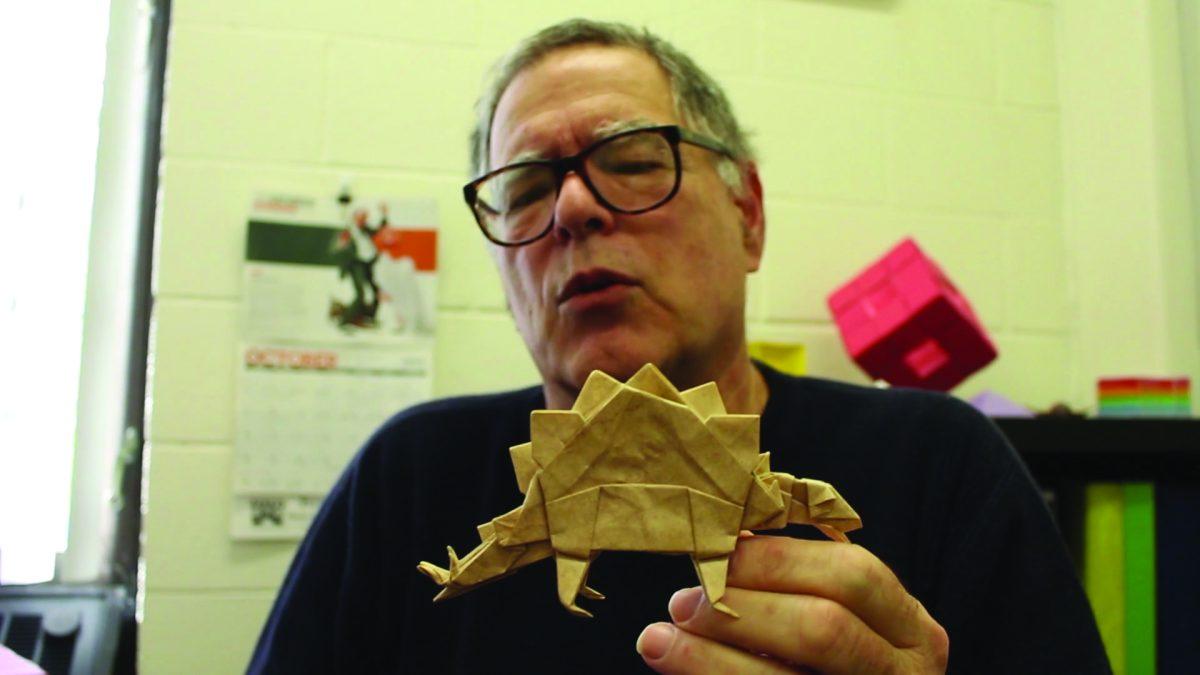A pair of worn hands glide along a thin black plane of paper. One finger digs underneath an edge and folds over itself revealing red on the opposite side of the sheet. It happens again, but this time from a different angle. Over and over again, twisting, bending, the hands sculpting something that resembles people, a couple dancing, one crimson with a warm crimson dress, the other in a deep black tuxedo.
The man who made this has been doing so nearly all his life, but his reintroduction to origami was sparked by the Internet almost 20 years ago.
Now, as a mathematics professor at Rowan University, Professor Ira Fine considers it an opportunity to take a break from the exact precision of calculations that his profession requires, into something more imperfect.
“There’s a jump you have to take from mathematics to origami, from the theorized to the real world,” Fine said.
On the door of his office, in the corner of the mathematics department of Robinson Hall, an origami ghost sits on top of his nameplate. Inside is the collection of his origami work.
But his career in mathematics and love for origami was not always such a coinciding sanctuary in Fine’s life.
As a child, he was introduced to origami by his parents, who would create a few basic projects like the frog and crane. He gained a collection of a few instruction books that taught more experienced origami. It was during this time when his skills were shaped into his DNA, even during his break from it all. Eventually, he hit a plateau that ended his interest in the art form. Instead, he directed his attention to what had already been growing, mathematics.
“It involved logical thinking, which I always liked,” Fine said.
His intellect continues today. He sporadically springs himself into an intellectual rampage, this time about a cube. His explanation of a cube can be difficult to understand. He is not concerned with the outside; it is the inside that he ponders over.

He takes a bright orange cube from his desk and untangles it into four isosceles pyramids using his own origami.
“Most people don’t think of a cube that way,” Fine said. “You’ll never think of a cube the same way again.”
Mathematics played a big part while growing up. Unlike origami, he could see a career in the field. An intense interest and skill in mathematics during high school proved him as an exceptional student. In the late 1960s, he earned his way into Yale University. As a freshman, he was chosen to participate in a highly prestigious concentrated group of first-year mathematics majors. The dreams of having a successful mathematics career seemed to be in the palm of his hands.
“You know that old expression, ‘drugs, sex, and rock and roll,’ that was big time on college campuses back then,” he said.
It was the late 60s and early 70s when Fine’s ambitions slipped away into the abyss of “all those other things.”
It was the distractions mixed with a discomfort in the social aspect at Yale that finally persuaded him to drop out after two years.
“I got to the point where I just didn’t want to be there anymore,” he said.
He left behind the prestigious college, and an ambitious career, and had still gone years without any origami. His life became a mess of odd jobs and situations, “floating” between one another, he explained. For the young Fine, he finally decided it was time to grow up and make a life for himself.

“As everybody eventually comes to in their life, although sometimes I guess some people never come to this, you gotta find something to do where you can earn a living,” Fine said.
He went back to earn his degrees in mathematics, a subject that he knew best. It was around the time when be first became a professor at Rowan when the correlation of mathematics and origami began.
“About 20 years ago or so, a very interesting thing happened, and it was called the Internet,” Fine said.
The information era had worked to Fine’s benefit. A new level of communication, knowledge, and technique in the world of origami was pleasantly introduced back into Fine’s life.
“I had a very, more intense interest in the hobby ever since then,” he said.
Now, he has learned to incorporate the art form into his teachings. In a sort of collaboration between the two, he lets his students see both the practical and fun side of mathematics.
“The students seemed to really enjoy the beautiful objects that he makes,” said mathematics professor Ronald Czochor, about an occasion where Fine shared his origami with freshman mathematics students during the Mathematics Learning Community initiative, in which first-year students are introduced to faculty members and different areas of interest in mathematics.
“Hopefully they got a sense of how this interesting art form, but also that this is very closely related to mathematics in lots of different ways, and I think they did,” said Czochor.
Keyna Farley, a senior English major, took Fine’s class for a required math course.
“He explains things to the point that where it’s almost impossible to not understand it,” said Farley.
Mathematics was not Farley’s strongest subject. She took the class with Fine in the spring semester of her freshman year.
“It’s really funny because he’ll design something based off of a certain holiday,” Farley said.

When Fine makes origami, he considers it an act of putting everything together as one. He likes to think that origami is comparable to the song “All Together Now” by The Beatles.
He has figured out a way to bring together his career and his passionate hobby into a cohesive learning experience for students. But for him, it is more of a way to feel enjoyment than it is anything else.
Students who see him now, like the alumnus student who ran into him at a coffee shop recently, remember his style of teaching.
“He told me, ‘I remember folding the turkey for Thanksgiving but not any math,” Fine said with a smile.
For comments/questions about this story, email [email protected] or tweet @TheWhitOnline.
























































































































































!["Working with [Dr. Lynch] is always a learning experience for me. She is a treasure,” said Thomas. - Staff Writer / Kacie Scibilia](https://thewhitonline.com/wp-content/uploads/2025/04/choir-1-1200x694.jpg)










































